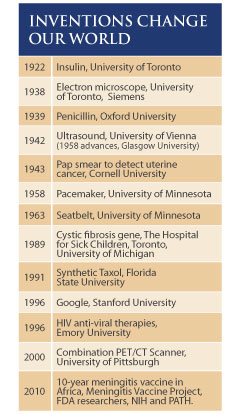What is Technology Transfer?
Universities are society’s greatest conduit for advancing medicine, technology, agriculture and public health, thereby improving quality of life globally by transforming research into innovation. This process, known as technology transfer, begins with identifying discoveries that are protectable and marketable from a broad range of invention disclosures, and shepherding those technologies into the commercial marketplace where they can improve lives and drive growth.
“Researchers come up with the best ideas, but unless those ideas are transformed into products and services, they won’t impact the lives of those around us.”
Moving a cutting-edge idea from a university laboratory to the real world requires strategic partnerships to commercialize these emerging inventions. Technology transfer offices play a crucial role in the process by identifying developments ripe for translation to real world solutions, obtaining patents and copyrights that protect them, and licensing products and processes to existing companies (or forming new businesses) to produce and market the products or services. AUTM champions and assists that process and its practitioners to ensure research is translated into accessible solutions to benefit humanity.
Check out the latest facts and figures in Technology Transfer

Research advances the economy and improves lives:
Technology Transfer is the process that fuels those advances
Why is Tech Transfer Important?
FROM PUBLIC SERVICE TO MARKETPLACE
Universities and research institutions are fertile places for groundbreaking discoveries; they’ve birthed hundreds of inventions, from polio vaccine to the barcode, to high-powered microscopes and Honeycrisp™ apples. While striving to be economic engines, academic institutions also must keep their focus on a higher purpose — education, public service and dissemination of knowledge. The purpose of AUTM is to assist technology transfer offices by providing networking, advocacy and educational opportunities for its members. While universities are focused on teaching and education, their researchers seek novel approaches to solve societal needs.
Technology transfer professionals make sure intellectual property is optimally protected and search for qualified commercial partners who can bring these discoveries to the marketplace. After finding the right commercial partner or startup company, they manage that relationship to ensure the technology is successfully and diligently developed. The right commercial partner can spark more innovation at the university, and thus more economic activity beyond its borders. In this way, technology transfer supports all the pillars of the new global economy: innovation, technology, entrepreneurship and knowledge.
“Academic technology transfer offices play a vast role in getting translational research into the hands of commercially capable entities. AUTM recognizes the common goals of the various technology transfer segments and is uniquely positioned to shape policies and processes through education, advocacy and metrics.”
BUILDING A KNOWLEDGE-INNOVATION ECONOMY
In pursuit of growth in the global economy, the U.S. National Research Council names research universities the nation’s “most potent asset.” As prominent sources of invention, universities and research institutions are generators of knowledge, innovation, technology and entrepreneurship, making them true engines of the new economy. In this knowledge-based environment, intellectual property is currency. As new technologies are transferred from one organization to another for development and commercialization, barriers break down, collaborations take place and solutions to global problems begin to emerge.
AUTM members play a critical role in ushering new technologies to market, often educating new entrepreneurs along the way. Even in the tech-driven economy, managing human relationships is a key part of the process. Technology transfer professionals must nurture these relationships while balancing the demands of faculty, commercial interests and broader campus goals. From 1996 to 2013, the economic impact of university and nonprofit patent licensing was more than $500 billion on the U.S. gross domestic product.*
INTEGRATING THE COLLABORATIVE ROLE
As technology transfer has become increasingly recognized for the role it plays in the knowledge-based economy, it also has become more integrated into many universities. Along with that change, the role of the technology transfer office also has evolved. Collaboration among colleges and community partners creates synergistic opportunities and increases the success rate of commercializing these discoveries.
Over the past 20 years, academic technology transfer has supported the creation of nearly 4 million jobs, one of the most active growth sectors of the global economy. Additionally, technology transfer provides companies with a rich source of intellectual properties to incent investment in early-stage technologies. The right commercial partner can help advance research and, in the case of human therapeutics, guide new products through the legal approval process. Companies like Lilly, Allergan, Merck and Boeing are a few of the leaders in licensing technologies from universities and turning them into innovative products that benefit the public.
* Biotechnology Industry Organization: The Economic Contribution of University/Nonprofit Inventions in the United States: 1996-2013; March 2015.

